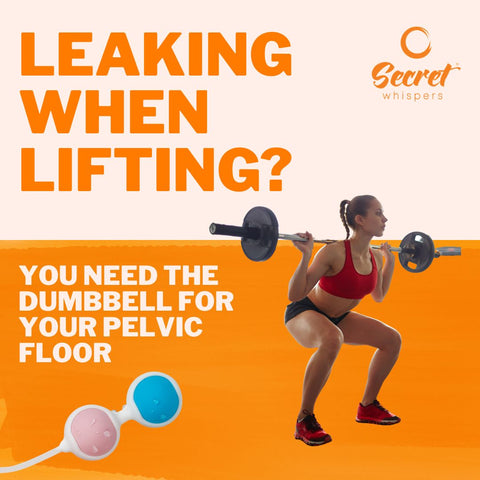Squats, Incontinence and The Pelvic Floor – All You Need to Know
Just as we discussed previously in our blog on ‘Cycling and the Pelvic Floor’, we are all aware of the importance of keeping fit. Unfortunately, when we are faced with the problems surrounding a weak pelvic floor, it is common to avoid doing exercise because we are worried we may leak and this can obviously be embarrassing.
However, keeping fit and keeping our weight down can help reduce the strain on our pelvic floor muscles, see Strong Body = Strong Pelvic Floor
A great starting place to help improve the fitness of your pelvic floor is with Secret Whispers 30 Day Pelvic Floor Challenge that starts on the 20th March. Limited spaces. Check out the reviews.
Women get amazing results from these challenges.
You can also try our 4 Week Pelvic Floor Muscles Workout Programme, that you can do from the comfort of your home or even while away, Simply download to your laptop or phone and follow the videos at your own pace and your own time.
Additionally, more and more women are turning to the gym to lift weights, as we hear evidence that weight training has benefits both for weight loss but also for preserving muscle mass, and helping us live longer, with it being a recommended exercise as we age1. Once again, this is where a strong pelvic floor is needed.
In the 30 Day Pelvic Floor Challenge we teach how to lift, breathe correctly and engage your pelvic floor.

There are so many different challenges you can add to your squats.
Squats are often a fundamental part of a weight training routine, using either our own body weight, or adding a load for further resistance, like in the image above.
With the massive range of different squat types available, it’s hardly surprising it’s a stalwart go-to in our workouts, to keep the regime varied.
Squats burn calories and help us lose weight. They also lower our chances of injury to knees and ankles, by strengthening the tendons, bones and ligaments in those areas2. Add all that to the fact that squats can help us sculpt a booty to be proud of, so, what’s to lose?
Squatting is generally a safe exercise to perform, although it is important to ensure that, as with any exercise, you are doing it correctly to avoid injuring yourself.
Unfortunately, due to the position of your legs and pelvis during a squat, you could be seen as just asking for trouble. I mean, when faced with the problem of stress incontinence, the ‘sitting on the toilet’ position is the last place you want to find yourself, so it often seems like the best approach would be to just wipe all forms of squatting from your exercise routine altogether, but with the array of evidence about the benefits of squatting, why let your pelvic floor win?
Tip - Empty your bladder and bowel fully before exercise. Do some Kegel exercises before and after exercise.
What Happens When You Squat?
Performing a deep and controlled squat allows the pelvic floor to lengthen and strengthens the glutes, which in turn allows them to help support the pelvic floor muscles.
The pelvic floor is the layer of muscles that supports your pelvic organs, stretching like a trampoline structure from the tailbone to the pubic bone, and from one sitting bone to the other.
When we squat, it can be hard to maintain ‘the knack’ to prevent leaking whilst holding a position that is quite the opposite to what we naturally do when we need to pee.
Have a read of our 'Step By Step Guide To Do Kegel Exercises', for more information on Kegels and ‘the knack’). Because of this, plenty of women wonder if the act of squatting is bad for their pelvic floor muscles.
Are Squats Good for Your Pelvic Floor?
According to many sources on the internet3, generally speaking, squatting is not bad for your pelvic floor, as long as you ensure proper form4 (see Women’s Health4 to check this out if you are not sure).
How to Squat Properly
- Standing with feet hip-width apart hinge at the knees to come into a squat position – making sure your knees track over your toes and don't extend past.
- With the weight in your heels, push back up to standing, squeezing your glutes at the top. Repeat.
According to Womens Health magazine, there are five form ideals to keep in mind to squat correctly, as follows:
- Torso is upright
- Back is straight
- Knees track over (not past) the toes
- Hips dip below knee height
- Weight is in the heels
As previously mentioned, squats are the masters when it comes to strengthening our glutes, but strong glutes are not only important if we want to twerk our way through life though.
Squats are a great pelvic floor training buddy for the Kegels.
According to the National Association for Continence5 strong glues and hamstring are very important to the overall health of your pelvic floor, and one of the best exercises to develop these muscles is the deep squat.
This is one of the examples above in The 30 Day Pelvic Floor Challenge.
Can You Squat With Kegel Weights?
The answer to this question depends on you! Everyone’s body is different, and you may well find it difficult to keep the Kegel Weights in at all to start with and you may even find you can’t even stand up without feeling as though you are going to lose them!
This is perfectly normal, just persevere.
In no time at all, you will be able to hold them in for longer, and progress to adding in gentle exercise whilst wearing them. Once you feel able, it is perfectly ok to give you pelvic floor an extra work out by wearing them to go to the gym and squat away, feeling smug at your progress!
Whilst pelvic floor dysfunction can be embarrassing, inconvenient and uncomfortable, you are most definitely not alone in having to find a way to deal with it, and there is no reason why you should accept it, or let it stop you doing life your way. Secret Whispers Kegel weights are a great addition to your Kegel routine, to get you leak free in no time!
➡️ You can also join our fabulous womens only private Facebook Group
➡️ Fancy a FREEBIE? Download our FREE guide The easy way to get a stronger pelvic floor
➡️ Sign Up Now - The 30 Day Pelvic Floor Challenge - Starts 20th March 2023. Limited spaces
Any questions? Just email us at support@secretwhispers.co.uk and we will get straight back to you.
Never miss another blog again. Sign up now to my weekly Newsletter. You will get a 10% discount code to use too.Just click below ⬇️⬇️⬇️
External References
-
bbc.co.uk/news/health-63048474
-
https://www.webmd.com/fitness-exercise/health-benefits-of-squats#:~:text=Squats%20burn%20calories%20and%20might,off%20your%20knees%20and%20ankles.
-
https://www.strengthresurgence.com/pelvic-floor-squatting/
-
https://www.womenshealthmag.com/uk/fitness/strength-training/a708464/how-to-squat-properly/#:~:text=a)%20Standing%20with%20feet%20hip,Repeat.
-
https://nafc.org/step-4-start-implementing-exercises/














